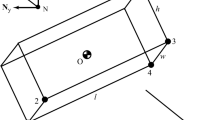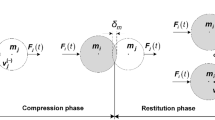Abstract
Modeling simultaneous contact and collisions at multiple surfaces in articulated rigid-body systems is computationally challenging because joint and contact constraints must be enforced together. Previously, we have proposed an efficient method to treat multi-surface collisions in the contact space coordinates which represent the relative motion at the contact surfaces [12]. The inertial dynamics of the multi-surface collision is then equivalent to a simultaneous collision between two rigid bodies whose inertia equals the effective inertia of the respective articulated bodies in the contact space. In this paper, we present an experimental study of this model on planar and spatial systems of passive jointed pendulums. Across several frictionless/frictional, single/multi-surface collision events, the model accurately predicted post-collision joint positions and velocities. Furthermore, joint velocity predictions in the dynamically consistent null space were significantly more accurate than those in the contact space. This indicates that the contact space model accurately describes inertial dynamics of multi-surface collisions in articulated rigid-body systems, but a better empirical restitution model can further improve prediction accuracy .
Access this chapter
Tax calculation will be finalised at checkout
Purchases are for personal use only
Similar content being viewed by others
References
Baraff, D.: Fast contact force computation for nonpenetrating rigid bodies. In: Proceedings of the 21st Annual Conference on Computer Graphics and Interactive Techniques, pp. 23–34. ACM (1994)
Conti, F., Khatib, O.: A framework for real-time multi-contact multi-body dynamic simulation. In: Robotics Research, pp. 271–287. Springer (2016)
Delp, S.L., Anderson, F.C., Arnold, A.S., Loan, P., Habib, A., John, C.T., Guendelman, E., Thelen, D.G.: Opensim: open-source software to create and analyze dynamic simulations of movement. IEEE Trans. Biomed. Eng. 54(11), 1940–1950 (2007)
Erez, T., Tassa, Y., Todorov, E.: Simulation tools for model-based robotics: comparison of bullet, havok, mujoco, ode and physx. In: 2015 IEEE International Conference on Robotics and Automation (ICRA), pp. 4397–4404. IEEE (2015)
Fazeli, N., Zapolsky, S., Drumwright, E., Rodriguez, A.: Fundamental limitations in performance and interpretability of common planar rigid-body contact models. arXiv preprint arXiv:1710.04979 (2017)
Featherstone, R., Orin, D.E.: Springer Handbook of Robotics - Dynamics
Flores, P., Ambrósio, J., Claro, J.P., Lankarani, H.: Influence of the contact–impact force model on the dynamic response of multi-body systems. Proc. Inst. Mech. Eng. Part K: J. Multi-body Dyn. 220(1), 21–34 (2006)
Khatib, O., Brock, O., Chang, K.S., Conti, F., Ruspini, D., Sentis, L.: Robotics and interactive simulation. Commun. ACM 45(3), 46–51 (2002)
Khatib, O., Chung, S.Y.: Suprapeds: humanoid contact-supported locomotion for 3D unstructured environments. In: 2014 IEEE International Conference on Robotics and Automation (ICRA), pp. 2319–2325. IEEE (2014)
Khatib, O., Sentis, L., Park, J., Warren, J.: Whole-body dynamic behavior and control of human-like robots. Int. J. Humanoid Rob. 1(01), 29–43 (2004)
Khatib, O., Yeh, X., Brantner, G., Soe, B., Kim, B., Ganguly, S., Stuart, H., Wang, S., Cutkosky, M., Edsinger, A., et al.: Ocean one: a robotic avatar for oceanic discovery. IEEE Robot. Autom. Mag. 23(4), 20–29 (2016)
Ruspini, D.C., Khatib, O.: Collision/contact models for dynamic simulation and haptic interaction. In: Robotics Research, pp. 185–194. Springer (2000)
Rusu, A.A., Vecerik, M., Rothörl, T., Heess, N., Pascanu, R., Hadsell, R.: Sim-to-real robot learning from pixels with progressive nets. arXiv preprint arXiv:1610.04286 (2016)
Stewart, D., Trinkle, J.C.: An implicit time-stepping scheme for rigid body dynamics with coulomb friction. In: IEEE International Conference on Robotics and Automation, 2000, Proceedings, ICRA 20000, vol. 1, pp. 162–169. IEEE (2000)
Stewart, D.E.: Rigid-body dynamics with friction and impact. SIAM Rev. 42(1), 3–39 (2000)
Stoianovici, D., Hurmuzlu, Y.: A critical study of the applicability of rigid-body collision theory. Trans.-Am. Soc. Mech. Eng. J. Appl. Mech. 63, 307–316 (1996)
Uchida, T.K., Sherman, M.A., Delp, S.L.: Making a meaningful impact: modelling simultaneous frictional collisions in spatial multibody systems. Proc. R. Soc. A 471, 20140859 (2015). The Royal Society
Acknowledgements
The authors would like to acknowledge the help of Anushka Nair and Chinmay Tyagi in performing the planar collision experiments. They also acknowledge Samir Menon for his insights. Toyota Research Institute (TRI) provided funds to assist the authors with their research but this article solely reflects the opinions and conclusions of its authors and not TRI or any other Toyota entity.
Author information
Authors and Affiliations
Corresponding author
Editor information
Editors and Affiliations
Rights and permissions
Copyright information
© 2020 Springer Nature Switzerland AG
About this paper
Cite this paper
Ganguly, S., Khatib, O. (2020). Experimental Studies of Contact Space Model for Multi-surface Collisions in Articulated Rigid-Body Systems. In: Xiao, J., Kröger, T., Khatib, O. (eds) Proceedings of the 2018 International Symposium on Experimental Robotics. ISER 2018. Springer Proceedings in Advanced Robotics, vol 11. Springer, Cham. https://doi.org/10.1007/978-3-030-33950-0_37
Download citation
DOI: https://doi.org/10.1007/978-3-030-33950-0_37
Published:
Publisher Name: Springer, Cham
Print ISBN: 978-3-030-33949-4
Online ISBN: 978-3-030-33950-0
eBook Packages: Intelligent Technologies and RoboticsIntelligent Technologies and Robotics (R0)




